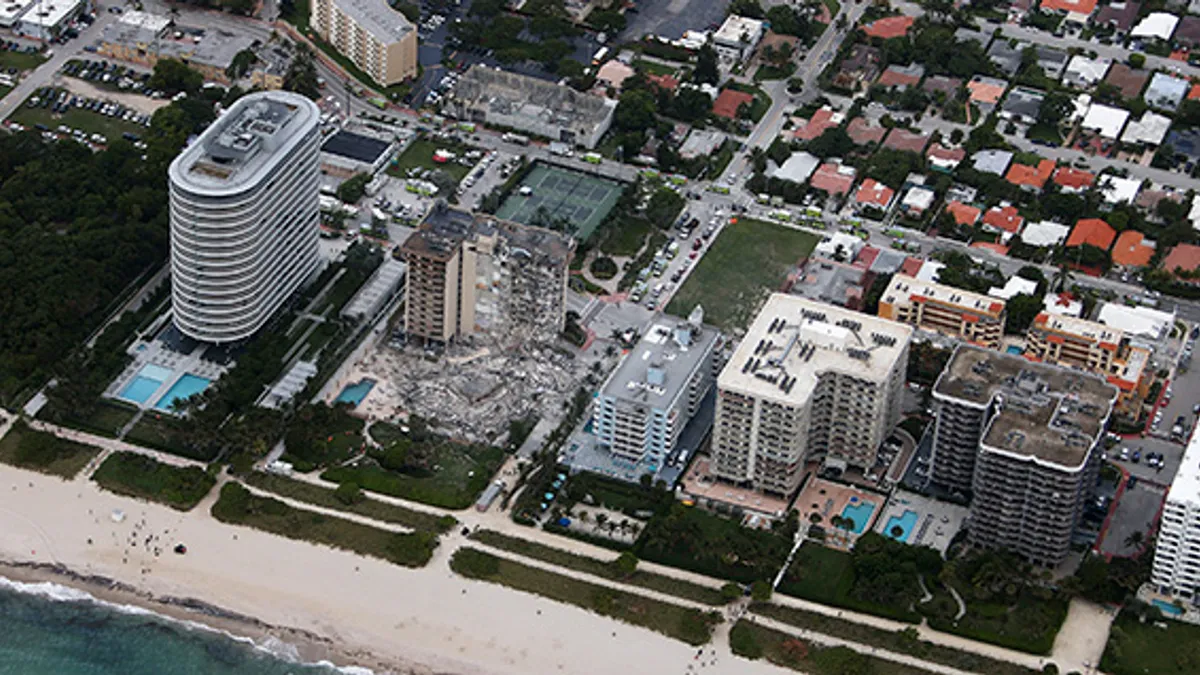Dive Brief
- Local officials are ramping up inspections and audits of high-rise buildings in Florida, while insurers nationally and residents as far away as California reconsider the implications of tower living in the wake of the Champlain Towers South condominium collapse.
- Miami-Dade County has reportedly upped its scrutiny of buildings currently undergoing the municipality's 40-year recertification process, while residents of the Crestview Towers in North Miami Beach were ordered to evacuate last week, after reviewing a six-month old engineer's report that warned of safety concerns, according to Miami's Local 10 News.
- In San Francisco, there were renewed concerns over the safety of the 58-story Millennium Tower, which is tilting and has sunk 18-inches since its opening in 2009. But Ronald Hamburger, the building's current engineer, said there were significant differences between the two buildings, and comparisons were "reckless."
Dive Insight
"Millennium Tower was designed to stringent earthquake resistance standards and is a much tougher form of construction than typical buildings in Florida, which are not required to be designed for earthquake resistance," Hamburger told CNN. "I can state with confidence that settlements experienced by Millennium Tower have not compromised its stability and safety."
The Champlain Towers South tragedy, which has gained worldwide attention and prompted President Joe Biden and First Lady Jill Biden to visit Surfside to view its aftermath last week, has also had further business ramifications.
The Miami Herald reported that insurance firms, already wary of the impacts of hurricanes, tropical storms and climate change, issued letters to several condo associations soon after Champlain South's collapse demanding proof of current inspections.
"This has kind of opened up everybody's eyes," Mike Clarkson, the president of national insurance brokerage Hilb Group of Florida, told the New York Times.
In San Francisco, some residents who bought into the ultra-luxury "city within the city" that Millennium Tower claims to be on its website, moved on after the discovery that the building was sinking and tilting, taking losses on their multimillion dollar units.
Attention to the issue rose in 2016, after 50th-floor residents Frank Jernigan and Andrew Faulk posted a video of a marble rolling across the floor that changed direction and doubled back on itself. That was followed in 2017 by a segment on "60 Minutes" called "The Leaning Tower of San Francisco."
Now, after years of lawsuits, a $100 million fix is set to be completed in 2022. It will involve driving piles into the bedrock that's beneath the softer soil of downtown San Francisco and connecting them to the building. Much of the city's waterfront area was built on fill that was pumped from the bottom of the Bay in the late 1800s and early 1900s.
"The structural upgrade currently underway at the tower is intended to prevent further settlement, and recover some of the building's tilt, rather than to repair damage or provide strengthening," Hamburger told CNN. "The building remains safe and is in no danger of collapse."
In Florida, the New York Times reported that Miami-Dade County officials were prioritizing 24 multistory buildings that failed 40-year inspections, or hadn't submitted documentation at all. The newspaper also reported that lax enforcement of existing rules contributed to that number – 17 of those cases have been open for a year or more.
Now, in the aftermath of Champlain South's collapse, that trend is reversing course, much like the marble Jernigan and Faulk rolled across the floor.
"All concrete cracks — it's made to crack," Allyn E. Kilsheimer, a structural engineer hired by Surfside to help investigate the Champlain Towers collapse, told the Times. "The issue is to understand what the crack is, what might have caused it if anything, and then making sure it doesn't cause more problems."















